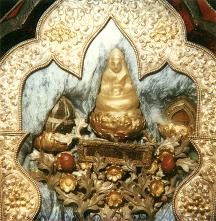Terma: Difference between revisions
Jump to navigation
Jump to search
mNo edit summary |
mNo edit summary |
||
| Line 1: | Line 1: | ||
[[Image:Guru dewachen statue.JPG|frame|]] | [[Image:Guru dewachen statue.JPG|frame|]] | ||
'''Terma''' ([[Wyl.]] ''gter ma'') — spiritual '''treasures''' hidden by [[Guru Rinpoche]] and [[Yeshe Tsogyal]] in the earth and in the minds of disciples to be revealed at the appropriate time by ‘treasure revealers’ or [[tertön]]s. Many of these ''ter'' were collected by [[Jamgön Kongtrul]] and [[Jamyang Khyentse Wangpo]] into more than sixty volumes, the ''[[Rinchen Terdzö]]'', or ''Treasury of Precious Termas'' | '''Terma''' ([[Wyl.]] ''gter ma'') — spiritual '''treasures''' hidden by [[Guru Rinpoche]] and [[Yeshe Tsogyal]] in the earth and in the minds of disciples to be revealed at the appropriate time by ‘treasure revealers’ or [[tertön]]s. Many of these ''ter'' were collected by [[Jamgön Kongtrul]] and [[Jamyang Khyentse Wangpo]] into more than sixty volumes, the ''[[Rinchen Terdzö]]'', or ''Treasury of Precious Termas''. | ||
[[Tulku Thondup]] writes: | [[Tulku Thondup]] writes: | ||
:“In order to prevent the deep teachings and sacred objects of [[tantra]] from becoming mixed, diluted, or lost in the distant future, and in order to maintain their [[blessing]] powers afresh for future followers, [[Guru Rinpoche]] and [[Yeshe Tsogyal]] concealed them. They are discovered at the appropriate time by realized masters through their enlightened power.”<ref>''Masters of Meditation and Miracles'', [[Tulku Thondup Rinpoche]].</ref> | |||
==Subdivisions== | |||
Termas can be divided into | |||
*‘[[earth terma]]s’ (Tib. ''sa ter''), which employ physical objects, and | |||
*‘[[mind terma]]s’ (Tib. ''gong ter''), discovered within the mindstream of the tertön. | |||
[[Sogyal Rinpoche]] writes: | [[Sogyal Rinpoche]] writes: | ||
:‘Terchö’ literature can be in three parts: Lama, [[Dzogchen]] & Tukjé Chenpo (''la dzog tuk sum''), i.e. the peaceful and wrathful [[sadhana]]s on the Guru, teachings on Dzogchen and sadhana cycle on [[Avalokiteshvara]]. Another division is into [[Kagyé]], [[Lama Gongdü|Gongdü]] and [[Vajrakilaya|Phurba]]. | :‘Terchö’ literature can be in three parts: Lama, [[Dzogchen]] & Tukjé Chenpo (''la dzog tuk sum''), i.e. the peaceful and wrathful [[sadhana]]s on the Guru, teachings on Dzogchen and sadhana cycle on [[Avalokiteshvara]]. Another division is into [[Kagyé]], [[Lama Gongdü|Gongdü]] and [[Vajrakilaya|Phurba]]. | ||
:Examples of | :Examples of gong ter are: the [[Seven Treasuries]] of [[Longchenpa]], [[Tertön Mingyur Dorje|Mingyur Dorje]]’s [[Namchö]], [[Jikme Lingpa]]’s [[Longchen Nyingtik]] and the termas of Kyabjé [[Dudjom Rinpoche]]. Examples of 'pure visions' are: Yuthok Yönten Gonpo’s Yuthok Nyingtik, [[Lhatsün Namkha Jikmé]]’s [[Rigdzin Sokdrup]] and the Great [[Fifth Dalai Lama]]’s [[Gyachen Nyer Nga]].<ref>''[[Dzogchen and Padmasambhava]]'', [[Sogyal Rinpoche]].</ref> | ||
==Notes== | |||
<references/> | <small><references/></small> | ||
==Further Reading== | ==Further Reading== | ||
*Andreas Doctor, ''Tibetan Treasure Literature: Revelation, Tradition and Accomplishment in Visionary Buddhism'', Ithaca: Snow Lion, 2005 | *Andreas Doctor, ''Tibetan Treasure Literature: Revelation, Tradition and Accomplishment in Visionary Buddhism'', Ithaca: Snow Lion, 2005. | ||
*Dudjom Rinpoche, ''The Nyingma School of Tibetan Buddhism'', Boston: Wisdom, revised edition 2002 | *[[Dudjom Rinpoche]], ''The Nyingma School of Tibetan Buddhism'', Boston: Wisdom, revised edition 2002. | ||
*Janet B. Gyatso, 'Drawn from the Tibetan Treasury: The gTer ma Literature' in Cabezón and Jackson, ed., ''Tibetan Literature: Studies in Genre'', Snow Lion, 1996 | *Janet B. Gyatso, 'Drawn from the Tibetan Treasury: The gTer ma Literature' in Cabezón and Jackson, ed., ''Tibetan Literature: Studies in Genre'', Snow Lion, 1996. | ||
*[[Tulku Thondup]], ''Hidden Teachings of Tibet: An Explanation of the Terma Tradition of the Nyingma School of Buddhism'', Boston: Wisdom, reprint edition 1997. | |||
*Michael Aris, ''Hidden Treasures and Secret Lives'', Motilal Banarsidass, 1988 | *Michael Aris, ''Hidden Treasures and Secret Lives'', Motilal Banarsidass, 1988 | ||
==External Links== | ==External Links== | ||
Revision as of 16:59, 7 June 2009

Terma (Wyl. gter ma) — spiritual treasures hidden by Guru Rinpoche and Yeshe Tsogyal in the earth and in the minds of disciples to be revealed at the appropriate time by ‘treasure revealers’ or tertöns. Many of these ter were collected by Jamgön Kongtrul and Jamyang Khyentse Wangpo into more than sixty volumes, the Rinchen Terdzö, or Treasury of Precious Termas.
Tulku Thondup writes:
- “In order to prevent the deep teachings and sacred objects of tantra from becoming mixed, diluted, or lost in the distant future, and in order to maintain their blessing powers afresh for future followers, Guru Rinpoche and Yeshe Tsogyal concealed them. They are discovered at the appropriate time by realized masters through their enlightened power.”[1]
Subdivisions
Termas can be divided into
- ‘earth termas’ (Tib. sa ter), which employ physical objects, and
- ‘mind termas’ (Tib. gong ter), discovered within the mindstream of the tertön.
Sogyal Rinpoche writes:
- ‘Terchö’ literature can be in three parts: Lama, Dzogchen & Tukjé Chenpo (la dzog tuk sum), i.e. the peaceful and wrathful sadhanas on the Guru, teachings on Dzogchen and sadhana cycle on Avalokiteshvara. Another division is into Kagyé, Gongdü and Phurba.
- Examples of gong ter are: the Seven Treasuries of Longchenpa, Mingyur Dorje’s Namchö, Jikme Lingpa’s Longchen Nyingtik and the termas of Kyabjé Dudjom Rinpoche. Examples of 'pure visions' are: Yuthok Yönten Gonpo’s Yuthok Nyingtik, Lhatsün Namkha Jikmé’s Rigdzin Sokdrup and the Great Fifth Dalai Lama’s Gyachen Nyer Nga.[2]
Notes
- ↑ Masters of Meditation and Miracles, Tulku Thondup Rinpoche.
- ↑ Dzogchen and Padmasambhava, Sogyal Rinpoche.
Further Reading
- Andreas Doctor, Tibetan Treasure Literature: Revelation, Tradition and Accomplishment in Visionary Buddhism, Ithaca: Snow Lion, 2005.
- Dudjom Rinpoche, The Nyingma School of Tibetan Buddhism, Boston: Wisdom, revised edition 2002.
- Janet B. Gyatso, 'Drawn from the Tibetan Treasury: The gTer ma Literature' in Cabezón and Jackson, ed., Tibetan Literature: Studies in Genre, Snow Lion, 1996.
- Tulku Thondup, Hidden Teachings of Tibet: An Explanation of the Terma Tradition of the Nyingma School of Buddhism, Boston: Wisdom, reprint edition 1997.
- Michael Aris, Hidden Treasures and Secret Lives, Motilal Banarsidass, 1988